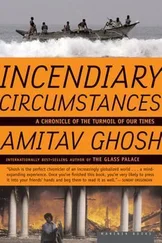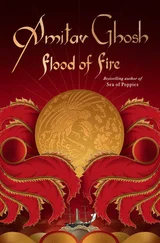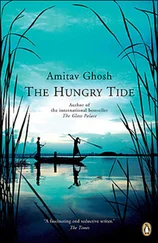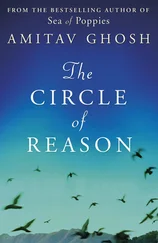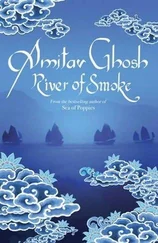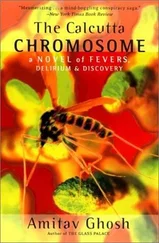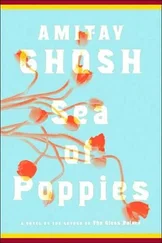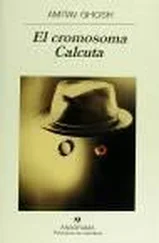Very few of the oo-sis, pe-sis and pa-kyeiks who lived in Huay Zedi were Burman by origin: some were Karen, some Karenni, some Pa-O, some Padaung, some Kadu-Kanan; there were even a few families of Indian mahout s, elephant trainers from Koraput, in the eastern Ghats. The inhabitants of the village kept to themselves and had little to do with plainspeople; Huay Zedi was a place that was entire unto itself, a part of the new cycle of life that had been brought into being by teak.
The village stood just above a sandy shelf where a chaung had strayed into a broad, meandering curve. The stream was shallow here, spread thin upon a pebbled bed, and through most of the year the water rose only to knee-height — a perfect depth for the villagers’ children, who patrolled it through the day with small crossbows. The stream was filled with easy prey, silver-backed fish that circled in the shallows, dazed by the sudden change in the water’s speed. The resident population of Huay Zedi was largely female: through most of the year the village’s able-bodied males, from the age of twelve onwards, were away at one teak camp or another up on the slopes of the mountain.
The settlement was ringed with immense, straight-limbed trees, growing thickly together to form a towering wall of foliage. Hidden behind this wall were vast flocks of parakeets and troupes of monkeys and apes — white-faced langurs and copper-skinned rhesus. Even commonplace domestic sounds from the village — the scraping of a coconut-shell ladle on a metal pot, the squeaking wheel of a child’s toy — were enough to send gales of alarm sweeping through the dappled darkness: monkeys would flee in chattering retreat and birds would rise from the treetops in an undulating mass, like a wind-blown sheet.
The dwellings of Huay Zedi differed from those of teak camps only in height and size — in form and appearance they were otherwise very alike, being built of identical materials, woven bamboo and cane, each being similarly raised off the ground on shoulder-high teakwood posts. Only a few structures stood out prominently against the surrounding greenery: a timber bridge, a white-walled pagoda and a bamboo-thatched church topped by a painted teakwood cross. This last was used by a fair number of Huay Zedi’s residents, many of whom were of Karen and Karenni stock — people whose families had been converted by followers of the American Baptist missionary, the Reverend Adoniram Judson.
When passing through Huay Zedi, Saya John stayed usually with the matronly widow of a former hsin-ouq, a Karenni Christian, who ran a small shop from the vine-covered balcony of her tai. This lady had a son, Doh Say, who became one of Rajkumar’s closest friends.
Doh Say was a couple of years older than Rajkumar, a shy, gangling youth with a broad, flat face and a cheroot-stub nose. When Rajkumar first met him, he was employed as a lowly sin-pa-kyeik , an assistant to a pa-kyeik, a handler of chains: these were the men who dealt with the harnessing of elephants and the towing of logs. Doh Say was too young and too inexperienced to be allowed to do any fastening himself: his job was simply to heft the heavy chains for his boss. But Doh Say was a hard and earnest worker and when Rajkumar and Saya John next returned they found him a pa-kyeik. A year later he was already a pe-si, or back-rider, working with an aunging herd, specialising in the clearing of streams.
At camp, Rajkumar would attach himself to Doh Say, following on his heels, occasionally making himself useful by lighting a fire or boiling a pot of water. It was from Doh Say that Rajkumar learnt to brew tea the way that oo-sis liked it, thick, bitter and acid, beginning with a pot that was already half stuffed with leaves and then replenishing it with more at every filling. In the evenings he would help Doh Say with the weaving of cane walls, and at night he would sit on the ladder of his hut, chewing betel and listening to the oo-sis’ talk. At night the herd needed no tending. The elephants were hobbled with chain-link fetters and let loose to forage for themselves in the surrounding jungle.
It was lonely at the camp, and Doh Say would often talk about his sweetheart, Naw Da, a girl in her early teens, slender and blooming, dressed in a tasselled white tunic and a homespun longyi. They were to be married as soon as Doh Say was promoted to the rank of oo-si.
‘And what about you?’ Doh Say would ask. ‘Is there a girl you’re thinking of?’
Rajkumar usually shrugged this off, but once Doh Say persisted and he answered with a nod.
‘Who is she?’
‘Her name is Dolly.’
This was the first time that Rajkumar had spoken of her and it was so long ago now that he could scarcely recall what she’d looked like. She was just a child, and yet she had touched him like no one else and nothing before. In her wide eyes, saturated with fear, he had seen his own aloneness turned inside out, rendered visible, worn upon the skin.
‘And where does she live?’
‘In India I think. I don’t know for sure.’
Doh Say scratched his chin. ‘One day you’ll have to go looking for her.’
Rajkumar laughed. ‘It’s very far.’
‘You’ll have to go. There is no other way.’

It was from Doh Say that Rajkumar learnt of the many guises in which death stalked the lives of oo-sis: the Russell’s viper, the maverick log, the charge of the wild buffalo. Yet the worst of Doh Say’s fears had to do not with these recognisable incarnations of death, but rather with one peculiarly vengeful form of it. This was anthrax, the most deadly of elephant diseases.
Anthrax was common in the forests of central Burma and epidemics were hard to prevent. The disease could lie dormant in grasslands for as long as thirty years. A trail or pathway, tranquil in appearance and judged to be safe after lying many years unused, could reveal itself suddenly to be a causeway to death. In its most virulent forms anthrax could kill an elephant in a matter of hours. A gigantic tusker, a full fifteen arms’ length off the ground, could be feeding peacefully at dusk and yet be dead at dawn. An entire working herd of a hundred elephants could be lost within a few days. Mature tuskers were valued in many thousands of rupees and the cost of an epidemic was such as to make itself felt on the London Stock Exchange. Few were the insurers who would gamble against a disease such as this.
The word anthrax comes from the same root as anthracite, a variety of coal. When anthrax strikes human beings it shows itself first in small pimple-like inflammations. As these lesions grow little black dots become visible at their centres, tiny pustules, like powdered charcoal: thus the naming of the disease. When anthrax erupts on an elephant’s hide the lesions develop a volcanic energy. They appear first on the animal’s hindquarters; they are about the size of a human fist, reddish-brown in colour. They swell rapidly and in males, quickly encase the penis sheath.
The carbuncles are most numerous around the hindquarters and as they grow they have the effect of sealing the animal’s anus. Elephants consume an enormous amount of fodder and must defecate constantly. The workings of their digestive systems do not stop with the onset of the disease; their intestines continue to produce dung after the excretory passage has been sealed, the unexpurgated fecal matter pushing explosively against the obstructed anal passage.
‘The pain is so great,’ said Doh Say, ‘that a stricken elephant will attack anything in sight. It will uproot trees and batter down walls. The tamest cows will become maddened killers; the gentlest calves will turn upon their mothers.’
They were at a camp together once when an epidemic struck. Saya John and Rajkumar were staying, as was their custom, with the camp’s hsin-ouq, a small, stooped man with a shoelace moustache. Late one evening Doh Say burst in to tell the hsin-ouq that an oo-si was missing: it was thought that he had been killed by his own elephant.
Читать дальше
Конец ознакомительного отрывка
Купить книгу


